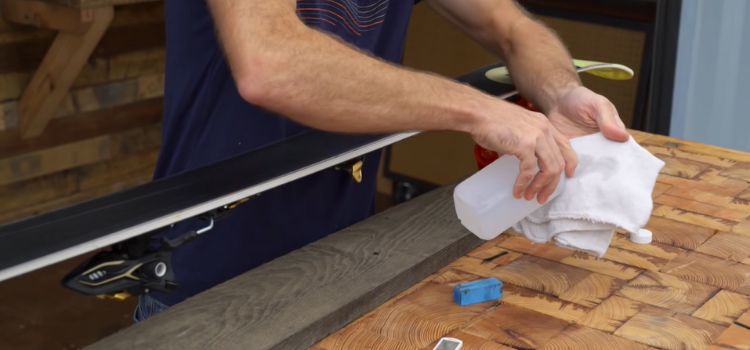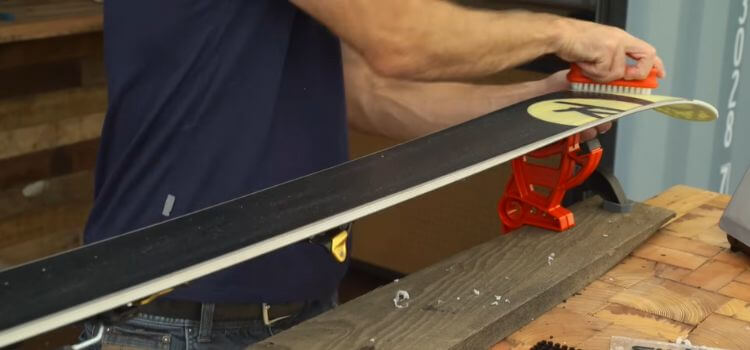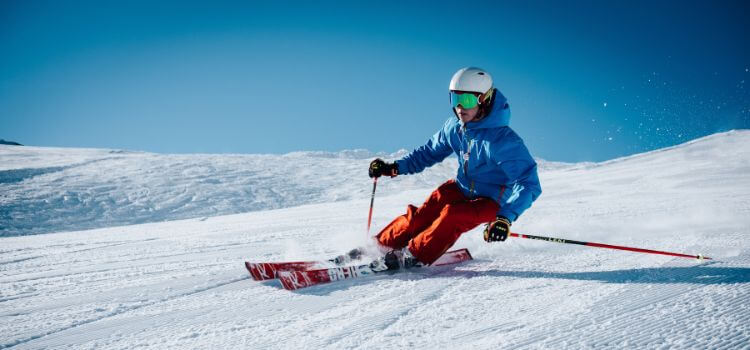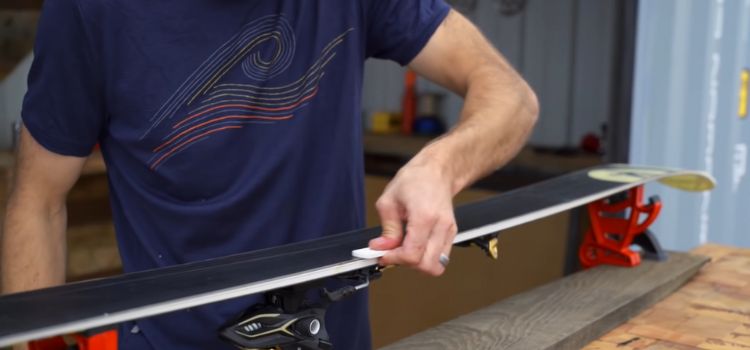As an Amazon Associate, I earn from qualifying purchases
To sharpen skis, inspect the edges, use a diamond stone to remove burrs, and clean off metal shavings. Then, polish the edges and inspect the base.
Methods Of Sharpening

Learn how to sharpen your skis at home with these informative videos and expert advice. Discover the best methods and tools to use, including diamond stones and edge tuners, to achieve a professional-level ski sharpening. Keep your skis in top-notch condition for optimum performance on the slopes.
When it comes to sharpening skis, you have a few different methods to choose from depending on your skill level and the tools available to you. Whether you prefer a hands-on approach or want to use specialized equipment, these methods will help you achieve those razor-sharp edges that enhance your skiing experience.
Sharpening By Hand
If you’re a DIY enthusiast or have limited resources, sharpening your skis by hand is a cost-effective option. It does require a bit more effort and skill, but with practice, you can achieve professional-grade results. Here’s a step-by-step guide on how to sharpen your skis by hand:
- Inspecting the edges: Start by examining the edges of your skis for any burrs, rust, or damage. Use a bright light and your fingertips to feel for irregularities.
- Filing the side edge: Use a ski-specific file or a fine-grit diamond stone to carefully file the side edges of your skis. Maintain a consistent angle and make slow, smooth strokes along the length of the ski.
- Removing sidewall material: If your skis have sidewalls, use a specialized tool to remove excess material before proceeding with the next steps.
- Prepping the edge with a diamond stone: Switch to a diamond stone with a medium grit to refine and smooth out the side edges. This step helps create a polished finish for optimal performance.
- Filing the base edge: Carefully file the base edge of your skis with a ski-specific file or a fine-grit diamond stone. Maintain a consistent angle and make slow, smooth strokes.
- Sharpening the skis: Use a diamond stone with a finer grit to further sharpen the side and base edges. Make sure to maintain the desired angle and apply consistent pressure.
- Polishing the edges: Finally, use a gummy stone or a polishing tool to smooth out any imperfections and give your edges a final touch of perfection.
Using Diamond Stones
Diamond stones are popular among ski enthusiasts for their precision and effectiveness in sharpening ski edges. They consist of a metal plate with diamond-embedded abrasive material. This method offers more control and precision compared to hand sharpening. Here’s how to sharpen skis using diamond stones:
- Inspecting the edges: Start by examining the edges of your skis using a bright light to identify any signs of damage, burrs, or rust.
- Removing burrs: Use a coarse-grit diamond stone to remove any burrs or irregularities from the edges. Make sure to follow the manufacturer’s instructions for proper technique and pressure.
- Prepping the edges: Switch to a medium-grit diamond stone and carefully run it along the side and base edges of your skis. This step helps refine the edges and create a smooth surface.
- Sharpening the edges: Progressively switch to finer-grit diamond stones to further sharpen and polish the edges. Move the stones along the edges with consistent pressure and in a smooth motion.
- Cleaning off metal shavings: After each pass with the diamond stone, wipe off any metal shavings using a clean cloth or brush. This will prevent them from interfering with the sharpening process.
- Polishing the edges: Finish the sharpening process by using a gummy stone or a specialized polishing tool to smooth out any remaining imperfections and add that final touch of perfection to your edges.
Gummy Stones
Gummy stones are a unique tool designed for maintaining ski edges and removing any built-up residue or small burrs. They are made of a rubbery material that can effectively clean and polish your ski edges. Here’s how to use gummy stones:
- Inspecting the edges: Begin by examining your ski edges for any dirt, wax, or small burrs that may have accumulated.
- Cleaning the edges: Use a gummy stone to gently rub along the edges, applying light pressure. This will help remove any dirt, wax, or small burrs that may affect your skiing performance.
- Polishing the edges: After cleaning the edges, continue to rub the gummy stone along the edges with slightly more pressure. This will further polish and smooth out the edges, enhancing their performance on the slopes.
Remember, regardless of the method you choose, always follow the manufacturer’s instructions for the tools and products you’re using. Additionally, if you’re unsure about your ability to sharpen skis, it’s always recommended to seek the assistance of a professional ski technician to ensure the best results for your equipment.
Step-by-step Guide
In this step-by-step guide, we will walk you through the process of sharpening your skis, ensuring they are in optimal condition for your next downhill adventure. It’s important to maintain sharp edges on your skis to ensure better control, precision, and safety on the slopes. Follow this guide to inspect your edges, remove burrs, clean off metal shavings, and polish the edges to keep your skis performing at their best.
Inspecting The Edges
Before you begin sharpening your skis, it’s crucial to carefully inspect the edges for any damage or irregularities. Inspecting the edges allows you to identify any dings or burrs that might affect your skiing experience. To inspect your skis’ edges:
- Use your fingers to run along the edges, feeling for any rough spots or irregularities. Pay close attention to the sidewalls, as these areas are prone to damage.
- Look closely for any visible burrs or rust on the edges. Burrs are small raised metal fragments that can affect your ski’s performance and should be removed.
- If you notice any significant damage or issues with your ski’s edges, it might be best to take them to a professional ski shop for repairs.
Removing Burrs

After inspecting your skis’ edges, it’s time to remove any burrs or irregularities that you identified during the inspection process. Burrs can be removed using the following steps:
- Start by using a diamond stone to file down the burrs. Gently run the diamond stone along the edge, applying consistent pressure to smooth out any rough spots.
- Continue filing the edges until you no longer feel any roughness or irregularities. Take your time and ensure you are smoothing out the entire length of the edges.
- Remember to file both the side edges and the base edges to ensure balanced performance.
Cleaning Off Metal Shavings

Once you have removed the burrs from your ski’s edges, it’s important to clean off any metal shavings that might have accumulated. Metal shavings can affect the smoothness of your ski’s edges and should be removed using the following steps:
- Use a gummy stone to gently rub along the edges, removing any fine metal shavings.
- Ensure you cover the entire length of the edges, paying extra attention to any areas that had significant burrs.
- Wipe off any remaining metal shavings with a clean cloth, ensuring the edges are free from debris before moving on to the next step.
Polishing The Edges
After removing burrs and cleaning off metal shavings, it’s time to polish your ski’s edges for a smooth and precise performance. Follow these steps to polish the edges:
- Begin by using a diamond stone progression. Start with a coarse stone and gradually work your way up to a finer stone. This will ensure a polished and sharp edge.
- Run the diamond stone along the edges, applying even pressure and consistent strokes.
- Keep polishing the edges until they feel smooth and sleek to the touch.
- After polishing, wipe off any residue or debris with a clean cloth.
By following this step-by-step guide, you can easily sharpen your skis at home, ensuring they are ready for a thrilling ride down the slopes. Remember to inspect your edges, remove burrs, clean off metal shavings, and polish the edges for optimal performance. Enjoy your next skiing adventure with well-maintained and sharpened skis!
Frequently Asked Questions Of How To Sharpen Skis
Can I Sharpen My Skis At Home?
Yes, you can sharpen minor edge work on your skis at home. However, for extensive repairs and sharpening, it is best to take them to a ski shop. Make sure to finish your tuning by waxing your skis, and it is recommended to regularly wax your skis throughout the ski season.
How Do You Service Skis At Home?
To service skis at home, start by cleaning them with a damp cloth and drying them well. Use a rough brush to clean any base damage. Then, apply a generous amount of wax over the entire base and edge using an iron.
Leave the wax on and store the skis in a dry, cool place.
How Do I Know If My Ski Edges Are Sharp?
To know if your ski edges are sharp, you can do a visual inspection. Look for any dull or rounded edges, nicks, or burrs. You can also run your thumb along the edge to feel for any roughness or inconsistencies.
If your edges feel smooth and sharp, they are probably in good condition.
How Do You Edge And Wax Skis?
To edge and wax skis at home, inspect the edges for burrs and rust. Use a diamond stone to remove burrs, followed by gummy stones to clean off metal shavings. Polish the edges and inspect the base. Then, set the side edge sharpness, file the side edge, remove sidewall material, and prep the edge with a diamond stone.
Finally, sharpen the edges, remove residue, and detune the tip and tail. Finish by hot waxing, scraping, and brushing.
Conclusion
To conclude, sharpening your skis is an essential part of ski maintenance that can greatly improve your performance on the slopes. By following the proper techniques and using the right tools, you can ensure that your skis are in top condition and ready for your next adventure.
Remember to regularly inspect and tune your ski edges, remove burrs and rust, and polish them for optimal performance. While minor edge work can be done at home, it’s always recommended to consult a ski shop for more extensive repairs and sharpening.
And don’t forget to wax your skis throughout the season to protect and enhance their performance. Happy skiing!
Read More
1. What Size Ski Poles Do I Need? The Ultimate Guide
2. How Long Do Ski Boots Last? Expert Tips Inside!
3. Best Ski Racks For Garage That Ensure Safe And Secure Storage
4. Best Ski Racks: Find The Perfect Solution For Your Winter Adventures
As an Amazon Associate, I earn from qualifying purchases



